Company commissions world’s largest fuel cell
Scaled up technology could power 1,400 family homes
Chemical and plastics giant Solvay made headlines this past week after it successfully commissioned the world’s largest Proton Exchange Membrane (PEM) fuel cell.

The Solvay PEM fuel cell in Antwerp, Belgium: (Via: discovery.com)
The 1-megawatt fuel cell is located at its SolVin plant in Antwerp, Belgium. SolVin is a market leader in PVC production.
How they’re doing it
Typically speaking, a fuel cell converts the chemical energy from hydrogen into clean electricity by way of an electrochemical reaction with oxygen. The technology is fast becoming a popular clean power generation alternative for several different applications, including cars, ships, and electricity generation devices.
Solvay’s PEM fuel cell converts co-produced hydrogen (H2 ) from the plant into electricity. It’s already been in operation for a few weeks now, and at the time this article is going live, it’s still in operation. In fact, it has generated over 500 MWh over the course of about 800 hours of operation, or about 33 days.
Real-world translation: these numbers are on par with the electricity consumption of nearly 1,400 families during the same time frame. What’s more, besides providing the plant with electricity, the fuel cell also increases SolVin’s brine electrolysis’ energy efficiency.
Solvay points to the project’s success as being a result of the fuel cell’s unique components. It is largely made up of Membrane Electrode Assemblies (MEAs). The manufacturer of these components is SolviCore, which is a 50-50 joint venture between Solvay and multinational material technology company, Umicore. The MEAs consist of Solvay’s specialty polymer, Aquivion PFSA membrane and ionomer, and Umicore’s elyst catalyst.
Dutch companies Nedstack and MTSA Technopower built the fuel cell using the SolviCore assemblies.
Outlook
The huge technological leap of faith was done in cooperation with WaterstofNet, the coordinator of the project Hydrogen Region Flanders — South Netherlands .
The purpose of this Project is to encourage clean energy ventures while also providing a better understanding about hydrogen applications in the region. Specific attention is paid to figuring out sustainable hydrogen and early market uses like maritime, logistical, and interurban applications.
The 1-MW PEM fuel cell described here marks the group’s first milestone for the Project. It is being used by WaterstofNet for research and test programs to endorse the implementation of fuel cell technology within the region. ■
Resources
News release via : solvay.com/EN/NewsPress/20120206_fuelcell.aspx
Advertisement
Learn more about Electronic Products Magazine





